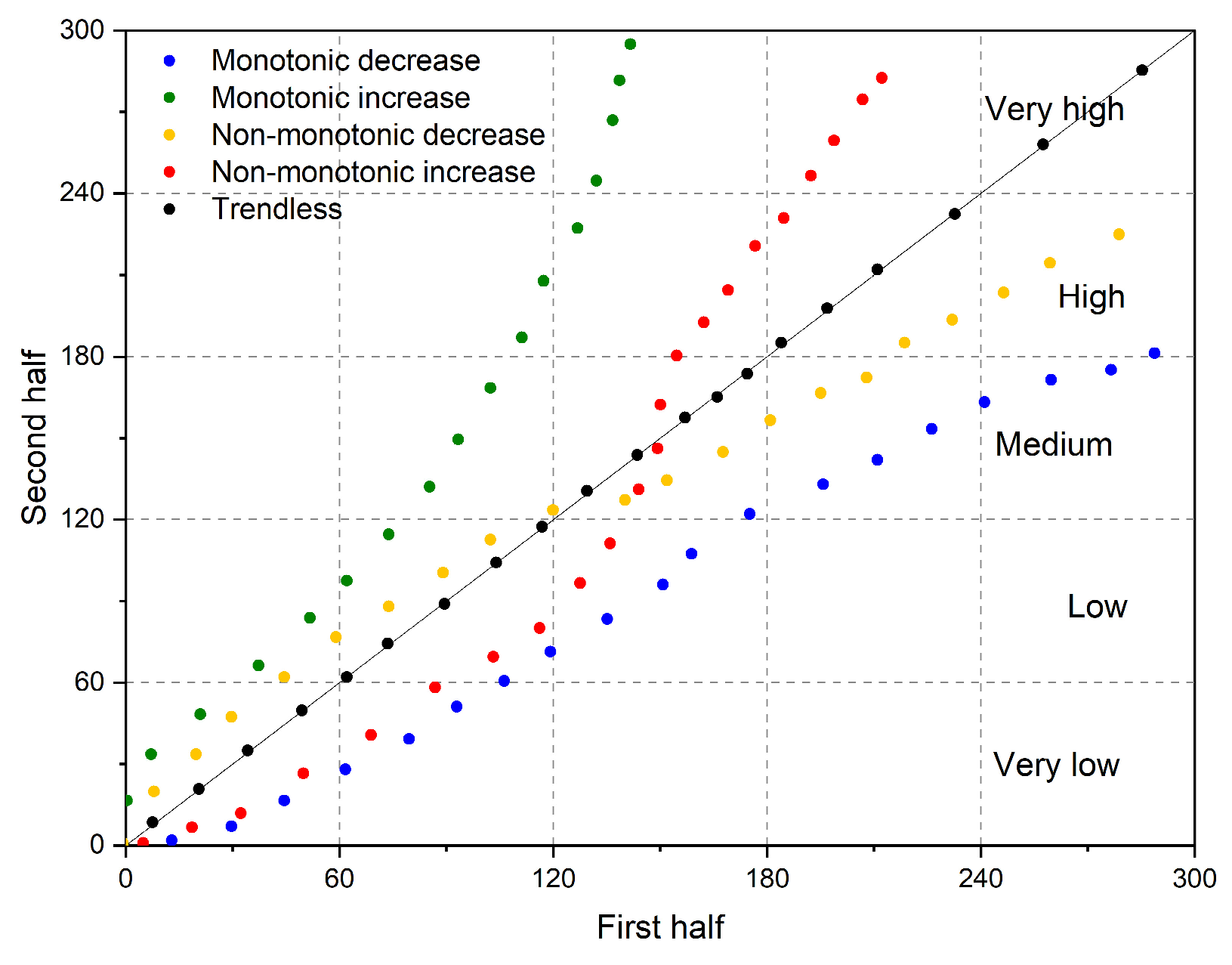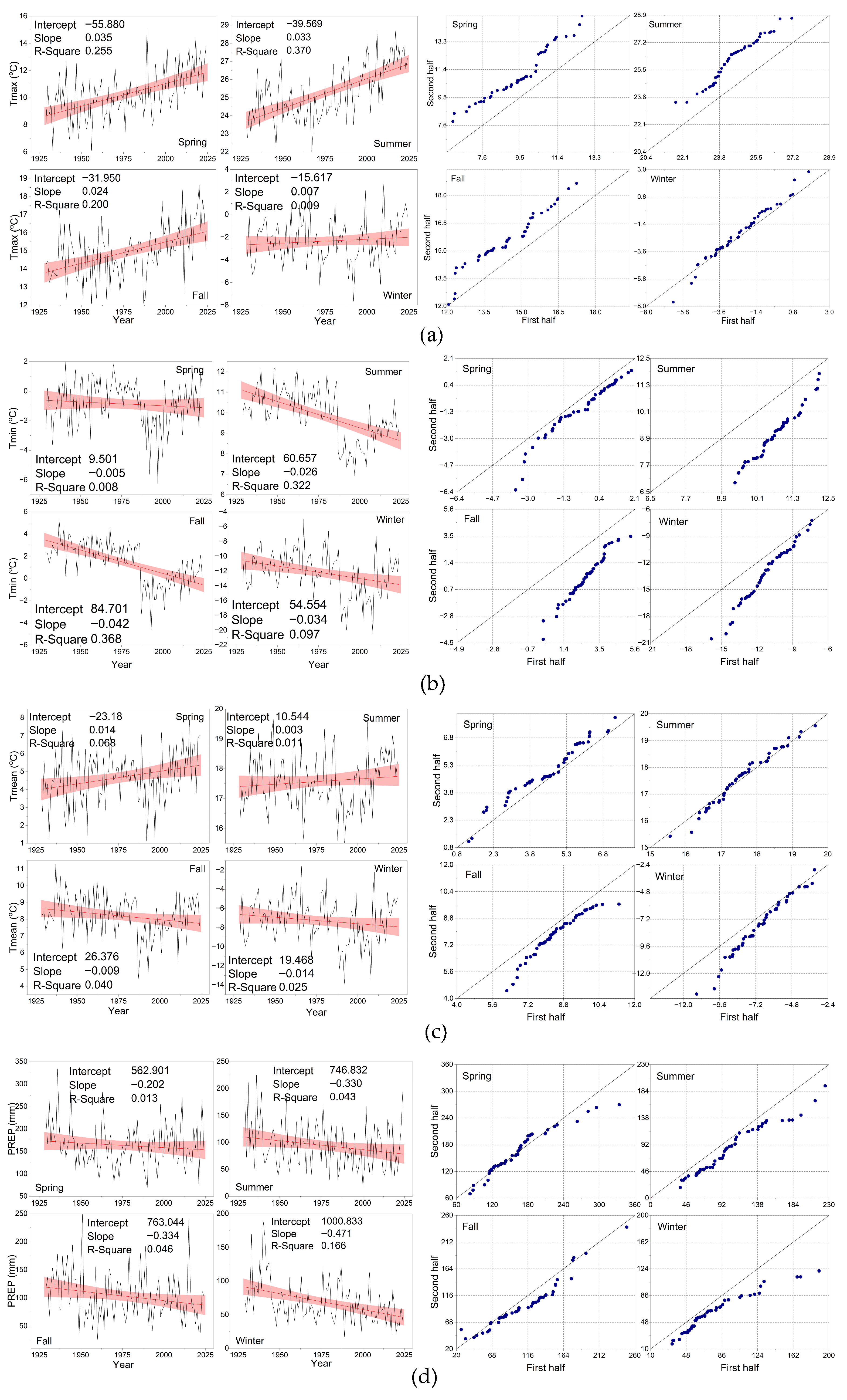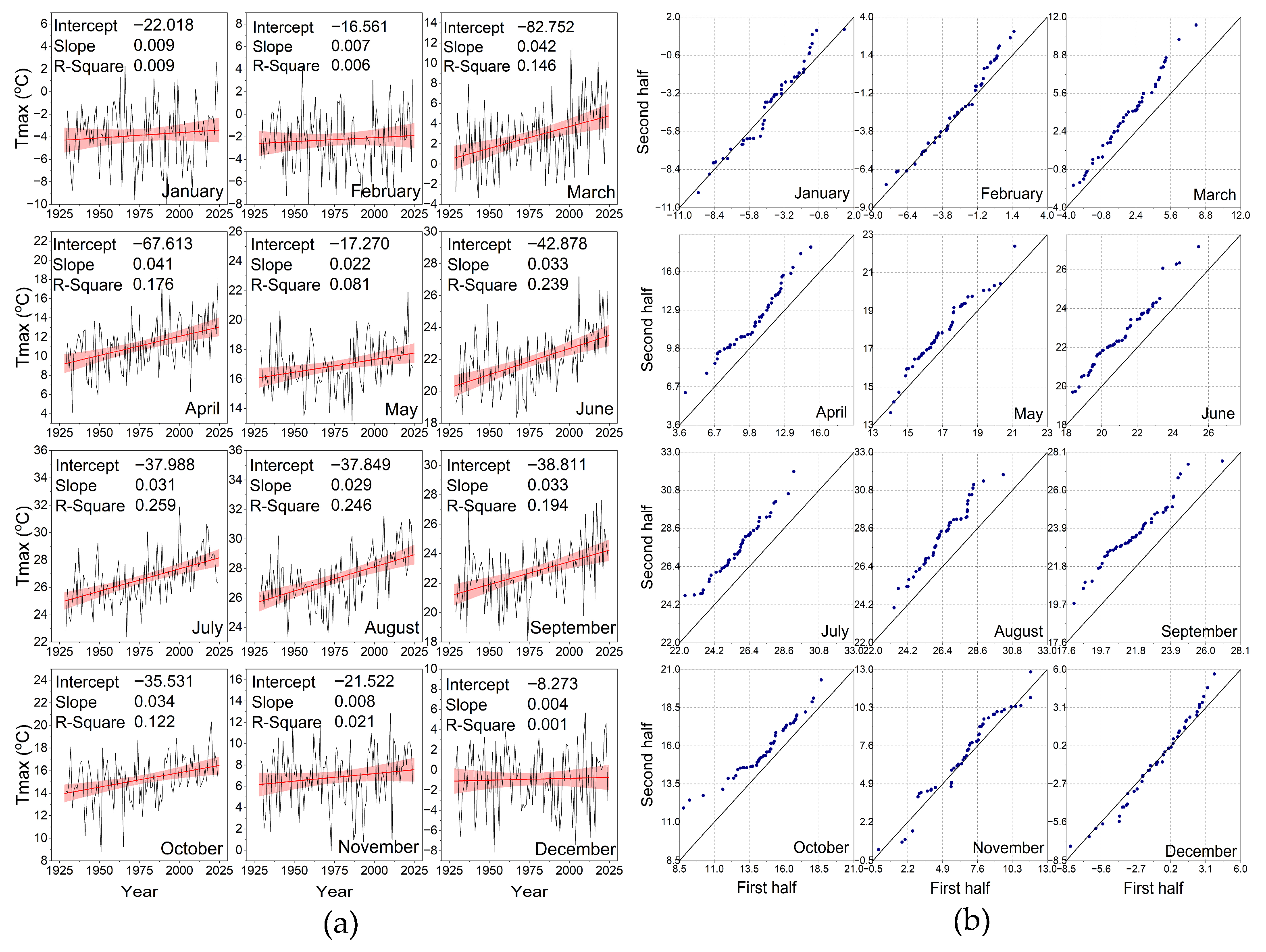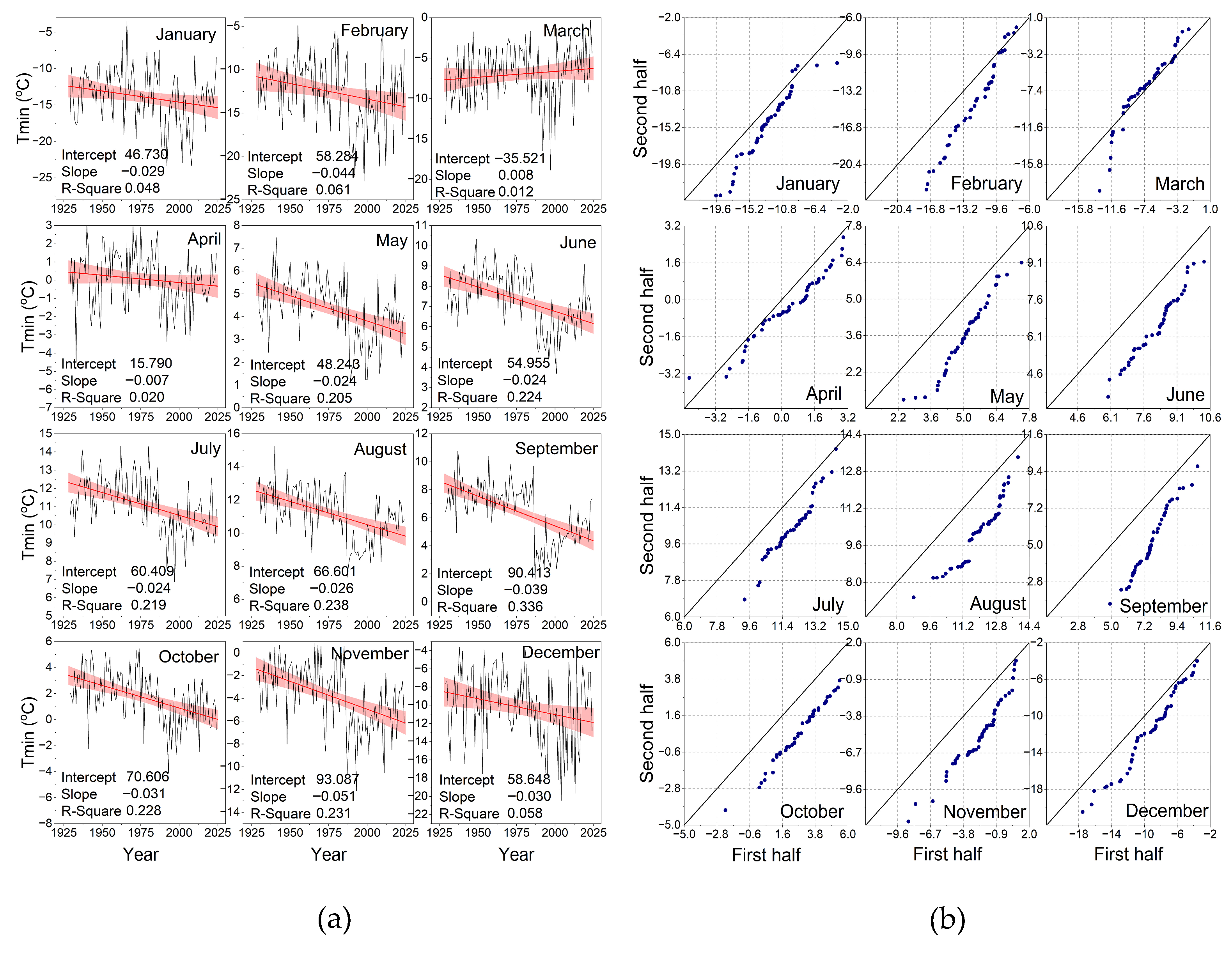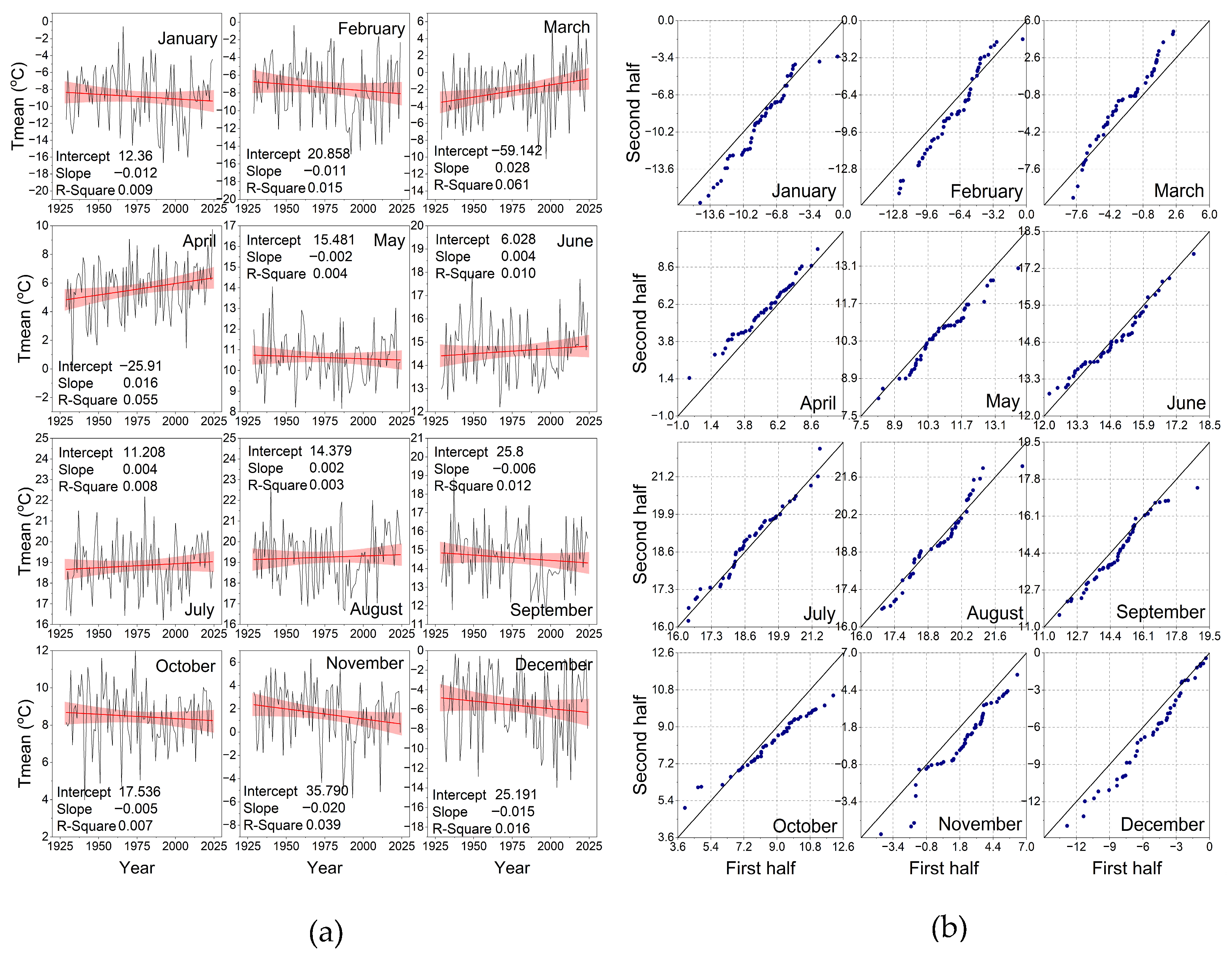Along with ITA charts, time series trends over a 96-year period and linear fit analyses for these trends are also displayed on the chart. This allows for the visualization of the variables’ temporal oscillations.
3.1. Annual Temperature and Precipitation Changes and Trend Analyses
Annual temperature and precipitation trends and their ITA plots are presented in
Figure 3. The trend plots in the left column of the figure clearly show the increasing trends in monthly maximum temperatures (
Figure 3a) and decreasing trends in minimum temperatures (
Figure 3b). T
max develops upwards with a linear slope of 0.024 °C/year (
R2 = 0.304) over the years, while T
min shows a downward trend with a slope of −0.027 °C/year (
R2 = 0.225). When the ITA plots in the right column of the trend plots are examined, monotonically increasing and monotonically decreasing scattering profiles for T
max and T
min, respectively, also clearly emerge. These strong trends can also be observed in the annual MK test results in
Table 1. The MK test
Z statistics are 5.56 and −4.02 for T
max and T
min, respectively, and their absolute values are significantly higher than the critical z value of 2.575 (99% significance level). Therefore, the
H0 hypothesis can be rejected for T
max and T
min, and it can be said that they exhibit increasing and decreasing trends, respectively. In
Table 2, the Sen slope for the T
max and T
min series is calculated as 0.025 °C/year and −0.023 °C/year, respectively. When evaluated from the layered perspective offered by the Sen approach, both series exhibit increasing and decreasing trends, parallel to the general trends in the “VL”, “L”, “M”, “H”, and “VH” categories.
The T
mean trend trends and ITA graphs in
Figure 3c show a very low decreasing trend. The slope in the annual trend graph was calculated as −0.001 °C/year (
R2 = 0.001). In
Table 2, Sen’s slope was also equal to this value, and decreasing trends were observed in all categories except “H.” However, according to the MK test results in
Table 1, the
H0: “There is no trend in the series” hypothesis cannot be rejected at any significance level (0.90, 0.95, and 0.99). The
Z value of −0.190 is only slightly below the critical
z value of 0.196 (α = 0.05).
For the precipitation trend graphs shown in
Figure 3d, the MK test in
Table 1 rejects the
H0 hypothesis, and the alternative hypothesis
H1, “There is a trend in the series”, is valid at a significance level of α = 0.05 (
Z = −2.90). In
Table 2, the Sen slope is calculated as −1.156 mm/year, and the categorical evaluation of the ITA profiles also shows decreasing trends for all categories (no data at the “VL” level). These results support the temporal trend graph profile.
3.2. Seasonal Temperature and Precipitation Changes and Trend Analyses
In the trend analysis of annual series for the period 1929–2024, the ITA profiles and MK test clearly show monotonic trends for the Tmax, Tmin, and PREP parameters, while the MK test for Tmean reveals no trend. The seasonal analysis, as well as the monthly analysis discussed in the next section, aims to identify trends at smaller time intervals.
Figure 4 presents the seasonal trends (left column) and their ITA profiles (right column) for each of the climate variables considered, presented in groups of four. The trend graphs for the T
max time series (
Figure 4a) in the left column show an upward trend in all seasons, parallel to the annual trend in
Figure 3. However, the trend for the winter season is lower than for the others. In summer, the T
max series fits a line with a slope of 0.033 °C/year with a regression coefficient of
R2 = 0.344, while in winter it follows a line with a lower slope of 0.007 °C/year (
R2 = 0.009). In spring and autumn, the series fits to lines with slopes of 0.035 °C/year (
R2 = 0.255) and 0.024 °C/year (
R2 = 0.200), respectively.
The ITA profiles presented in the right column of
Figure 4a, the MK test results in
Table 1, and the results of Sen’s innovative approach in
Table 2 support the view in the left column. According to the MK test, monthly average T
max values in spring, summer, and autumn exhibit an increasing trend at a significance level of 99%. The MK test
Z statistics for spring, summer, and autumn have values of 4.81, 6.16, and 4.47, respectively, and are significantly greater than the critical
z value of 2.575 (α = 0.01). According to the innovative trend analysis approach, there is no data in the “VL” category, which has low values in spring and summer, while there are monotonic increasing trends in the other categories of these seasons and in autumn. According to the MK test
Z statistics for winter (0.95), no significant trend is observed, and the
H0 hypothesis is accepted. According to the ITA profile, winter exhibits a non-monotonic increasing trend, with higher values in the “H” and “VH” categories, although fewer values are present, showing an increasing trend.
Figure 4b shows the trend and ITA graphs for the T
min series. The trend of the time series for all seasons follows a direction parallel to the annual trend, and all ITA profiles are monotonically decreasing. The slopes of the linear fit lines for all seasons except spring are greater than or close to the slope of the annual linear fit line, which is −0.027 °C/year (
R2 = 0.225). The linear fit slopes of the seasonal trends in autumn and winter are −0.042 °C/year (
R2 = 0.368) and −0.034 °C/year (
R2 = 0.097), respectively, while this value is calculated as −0.005 °C/year (
R2 = 0.008) in spring. According to the MK test results in
Table 1, the decreasing trend in the T
min series is statistically significant at the 95% significance level in winter and at the 99% significance level in summer and autumn. However, the trend in the T
min series in spring is not statistically significant at any of the selected significance levels (α = 0.1, α = 0.05, and α = 0.001), and the H
0 hypothesis cannot be rejected. Sen’s slope has values of −0.005, −0.023, −0.028, and −0.030 °C/year for spring, summer, autumn, and winter, respectively. There is no data in the “VH” category in autumn. Otherwise, there is a decreasing trend in all categories in all seasons. In spring, there is a large amount of data in the “H” and “VH” categories, where large values are present, while there is little data in the “VL” and “L” categories, where small values are present.
Figure 4c shows the trend and ITA plots for the T
mean series. The time series on the left show relatively increasing trends and positive slope values for spring and summer, while the opposite is true for autumn and winter. In the ITA scatter plots on the right, the autumn scatter plot exhibits a monotonic decreasing trend. A non-monotonic increasing trend can be observed in spring and summer, while the winter scatter plot resembles a non-monotonic decreasing trend. According to the MK test results summarized in
Table 1, the spring T
mean series has a
Z value of 2.45 (at an α = 0.05 significance level), indicating a significant increasing trend. In other seasons, the
Ho hypothesis should be statistically accepted, and there is no trend for the T
mean. The annual MK test results for the T
mean series also revealed that there is no trend, and that the Ho hypothesis is accepted. The significant increasing trend calculated in the spring T
mean series is not valid for the T
mean series for the rest of the year.
According to the MK test, while no trend was determined in average temperatures in the annual analysis covering the period 1929–2024, seasonal analyses revealed an increasing trend in average temperatures in the spring at a 95% confidence level. When Sen’s slope values are examined in
Table 2, it has a positive value (0.014, 0.005, and 0.007 °C/year) in spring, summer, and autumn, and a negative value (−0.012) in winter. This result may have been caused by the large dataset in the “VH” category in winter, i.e., the categories with the highest values. There are decreasing trends in the “VL” and “L” categories, i.e., the categories with smaller values, in spring, summer, and autumn. Consistent with the results of the MK test, there are increasing trends in the “VH” and “H” categories in spring.
One of the most striking results of the seasonal trend analyses of the selected climate variables was for monthly total precipitation. When the trend and ITA scatter plots of the PREP series shown in
Figure 4d are examined, the time series are fitted with a linear slope with a negative value, parallel to the annual decreasing trend in all seasons. The ITA scatter plots show a non-monotonic decreasing trend in spring and autumn, while monotonic decreasing trends are observed in summer and winter. For the annual PREP series, the MK and ITA tests also determined decreasing trends. The MK test in
Table 1 produced a
Z statistic of −0.93 for the spring PREP series. According to the selected significance levels (α = 0.1, α = 0.05, and α = 0.001), this value is less than the critical
z value, and therefore, the spring PREP series has no trend. According to the ITA results in
Table 2, the Sen’s slope for the spring PREP series was calculated as −0.156. According to subcategorization, the spring PREP series exhibits a decreasing trend in the “VL” category, which has the lowest values, no trend in the “L” category, increasing in the “M” category, and decreasing in the “H” category. The MK test calculated decreasing trends for the summer, autumn, and winter PREP series at significance levels of α = 0.1, α = 0.05, and α = 0.001, respectively. According to the ITA approach, decreasing trends are also observed in different subcategories in summer, autumn, and winter.
One of the most striking results of the trend analyses of the PREP series, as explained above, is that important details can be revealed when trend analyses conducted on an annual scale are performed on a seasonal scale. Another important point is that the highest average precipitation in Erzurum between 1929 and 2024 occurred in spring, with 163.2 mm (
Appendix A,
Table A5). According to the trend analyses, there is no decrease in precipitation trends in spring.
During the study period, the lowest average precipitation in Erzurum occurred in winter, at 68.9 mm. According to MK tests, precipitation tends to decrease in winter at a 99% significance level. In cities where precipitation occurs primarily as snow during the winter season (January, February, and December), snow water may be the most significant potential recharger of groundwater resources, as opposed to rainwater runoff from asphalt and concrete pavements due to unplanned urbanization. Therefore, the decrease in winter precipitation trends is another important result of the trend analyses of the PREP series. A similar assessment can be made for the summer season. A decrease in precipitation trends during climatically dry summers (average 94.4 mm) is a potential factor that could increase the risk of drought.
3.3. Monthly Temperature and Precipitation Changes and Trend Analyses
Conducting temporal trend analyses of climate variables separately on annual, seasonal, and monthly scales provides more detailed information about the smaller time intervals of each variable. The MK test results indicate that increasing trends are statistically significant in the annual trend analyses of the Tmax series. The ITA results also reveal monotonic increasing trends across all subcategories.
The MK test for seasonal trend analyses of the T
max series revealed no statistically significant trend in winter. Similarly, the ITA reveals increasing trends in the “H” and “VH” categories, where high values are found in winter, and decreasing or absent trends in other categories. The monthly trend analyses of the T
max series reveal monotonic increasing trends in March, April, June, July, August, September, and October, and nonmonotonic increasing trends in the other months (
Figure 5b). According to the MK test results in
Table 1, in line with the seasonal trend analysis, there are no statistically significant trends in the winter months (December, January, and February), nor in November. Increasing trends were calculated at a 95% significance level in October and 99% in other months. According to the ITA results in
Table 2, increasing trends are observed in all categories in March, April, June, and August, and in the “H” and/or “VH” categories during the winter months.
Figure 5b shows the high values in the “VH” categories of the ITA scatter plot for February, March, October, November, and December.
The monthly trend graph for the series in
Figure 5a also shows relatively flat lines in November, December, January, and February, fitting the series. The fit line with the highest slope was 0.042 °C/year (
R2 = 0.146) for March, while the slope with the highest regression coefficient (
R2 = 0.259) was 0.031 °C/year for July.
Table 3 was created to provide a simpler representation of the analysis results, which exhibit a more complex pattern as the annual scale progresses from a monthly scale, compared to the MK test. It can be easily seen from
Table 3 that the annual increasing trends for the temporal MK trend analyses described above for the T
max series become trendless in November and throughout the winter months as the temporal scale narrows.
Monthly trend and ITA scatter plots for the T
min series are given in
Figure 6. The trend profiles (
Figure 6a) show negative trends similar to the trend profiles of the annual and seasonal series except for March (slope = 0.008 °C/year;
R2 = 0.012). In
Figure 6b, the ITA scatter profile of the March series shows a non-monotonic decreasing trend, but the strong increasing trend in the “VH” category may be the reason for the positive slope of the linear fit line in the trend profile. When the trend profiles are examined, the smallest linear fit slope was −0.007 °C/year (
R2 = 0.020) for the April series, while the highest slope was 0.051 °C/year (
R2 = 0.231) for the November series. Monotonic decreasing trends are observed in the ITA scatter plots for all months except January, February, and March. With the exception of the increasing trend (a small number of values) in the “VL” category of April, decreasing trends are observed for all categories of all months.
An examination of the MK test results in
Table 1 reveals no statistically significant trend in the March and April series. Decreasing trends were calculated at a 95% significance level for the series in January, February, and December (winter months), and at a 99% significance level for the series in the remaining months. An examination of
Table 3, which summarizes the MK trend test results for the T
min series across all time intervals, reveals that the T
min series exhibited no trend in the spring months, March, and April, while they exhibited a decreasing trend in all other time intervals. The maximum value of the MK test statistic,
S (and
Z), was calculated as −1549.0 (and −4.90) for September, rejecting the
H0 hypothesis and accepting the
H1 hypothesis.
The trend profiles and ITA scatter plots of the monthly mean temperature series are presented in
Figure 7a,b, respectively. The linear fit lines of the time series for March, April, June, July, and August have positive slopes. The fit line with the highest slope was calculated for March at 0.028 °C/year (
R2 = 0.061). The fit lines of the T
mean series for the other months have negative slopes. The November fit line has the largest slope at −0.020 °C/year (
R2 = 0.039).
An examination of the ITA scatter plots of the T
mean series reveals monotonic increasing trends in April, nonmonotonic increasing trends in March and June, and monotonic decreasing trends in November. According to the ITA approach evaluation results presented in
Table 2, the November scatter profile exhibits a decreasing trend in all subcategories, and the Sen’s slope is −0.016 °C/year. For March and April, the “VL” category, which contains the smallest data values, exhibits decreasing trends and no data, respectively, while the other subcategories exhibit increasing trends. The MK statistics in
Table 1 also produce results supporting these trends. The
H0 hypothesis was rejected for March, April, and November. Despite the presence of increasing trends at the 95% level in March and April and decreasing trends at the 90% level in November, there is no statistically significant trend at the selected significance levels for all other months. According to the MK aggregate evaluation results for the T
mean series presented in
Table 3, there are positive trends in the spring, March, and April, negative trends in November, and no trends in the other time periods.
The trend graphs and ITA scatter plots of the monthly total precipitation series are presented in
Figure 8. When the trend profiles in
Figure 8a are examined, the slope of the linear fit lines of the time series is negative in all months. The slope (and
R2) values range between −0.218 mm/year (and
R2 = 0.132) and −0.035 mm/year (and
R2 = 0.001). The ITA scatter plots in
Figure 8b show monotonic decreasing trends in January, February, March (with the exception of one data point above the 1:1 line), June, and September, nonmonotonic increasing trends in April, and nonmonotonic decreasing trends in the other months. Decreasing trends are observed in all categories of all months that exhibit monotonic trends, except for the “H” and “VH” categories of January and the “VH” categories of February and September, for which no data are available (
Table 2).
During the 1919–2024 period, the highest average precipitation in Erzurum occurred in the form of rain in May (73.1 mm), April (54.6 mm), and June (48.5 mm). The lowest precipitation occurred in summer rain in August (17.6 mm) and snowfall in January (21.5 mm), December (22.0 mm), and February (25.4 mm). Precipitation statistics can be found in
Table A5 of
Appendix A. The May ITA scatter profiles show a trendless appearance until the decreasing trend in the “H” and “VH” categories, where the highest total precipitation values are found. In April, the ITA scatter profiles show a trendless appearance until the increasing trend in the “VH” category.
Table 1 shows that, according to the MK test results, there is no statistically significant trend in the PREP series in either of these months, meaning that the Ho hypothesis is accepted. In
Table 1, the ITA evaluation results for June show a Sen slope of −0.216 mm/year, and there are also decreasing trends in the “VL,” “L,” “M,” and “H” categories (no data in the “VH” category). The MK test also found a decreasing slope at the 95% significance level (
Z = −0.210).
Apart from the increasing trends in the “VL” category in August and the “M” category in December (no data in the “VH” category), there are decreasing slope profiles in other subcategories. However, the MK test shows no statistically significant trend for these months, while decreasing trends are found in January and February at the 95% (Z = −2.62) and 99% (Z = −3.70) significance levels, respectively. According to the same results, November precipitation tends to decrease at the 90% (Z = −1.65) significance level.
When the monthly PREP series are evaluated with the results of the annual and seasonal series, it is seen that in winter, January and It is clear that February snowfall is showing a significant downward trend. While the decrease in total precipitation in November and June in the fall is significant enough to influence seasonal trends, the decreasing trend in March precipitation in the spring is not significant enough to significantly impact seasonal statistics (
Table 3).

